Even IT professionals are confused about what constitutes Web 2.0, according to a survey released Wednesday by web security vendor Websense and research firm Dynamic Markets.
According to the survey, of 1,300 information technology managers across 10 countries, 17 percent of respondents correctly identified all the items on the survey that can be considered Web 2.0. IT administrators commonly identified the “obvious” Web 2.0 sites -- such as the social networking sites Facebook and LinkedIn, Dave Meizlik, director of product marketing at Websense, told SCMagazineUS.com on Tuesday. They also commonly identified blogs and micro blogs, such as Twitter, as Web 2.0. But, respondents less frequently identified other sites as Web 2.0, including iGoogle and Wikipedia, Meizlik said.
Only half of respondents identified video uploading sites, such as YouTube, as part of Web 2.0, the survey found.
David Lavenda, vice president of marketing and product strategy at security vendor Worklight, told SCMagazineUS.com on Wednesday that IT administrators know they need to secure the enterprise from Web 2.0 threats, but are not always sure what those threats are.
“When you go to organizations where security is really important -- financial and government organizations -- and ask, ‘What's your fear of Web 2.0?,' they say, ‘I really don't know, but we hear enough stories of people being compromised that we don't want to take a chance.' That's the most common answer.” Lavenda said.
Organizations should be concerned about data leakage -- users posting confidential company information which could have regulatory implications and cause a loss of customers, Meizlik said. Also, malware is much more prevalent in a world where users are creating their own content, Lavenda said.
The Websense survey also found that IT departments are being pressured by workers to enable more Web 2.0 sites. And, that pressure is often coming from top-level executives. Thirty percent of respondents said they were pressured by C-level executives and director-level staff to allow more access to Web 2.0 sites and technologies, the survey found. In addition, 34 percent felt pressure from marketing departments and 32 percent felt pressure from sales departments to do so.
Another recent study, conducted by Forrester Research, found that Web 2.0 use in business is prevalent, and web filtering is changing as a result. Web filtering today goes beyond just blocking access. It now must involve the integration of Web 2.0, data leakage management and malware protection, the Forrester study concluded.

According to the survey, of 1,300 information technology managers across 10 countries, 17 percent of respondents correctly identified all the items on the survey that can be considered Web 2.0. IT administrators commonly identified the “obvious” Web 2.0 sites -- such as the social networking sites Facebook and LinkedIn, Dave Meizlik, director of product marketing at Websense, told SCMagazineUS.com on Tuesday. They also commonly identified blogs and micro blogs, such as Twitter, as Web 2.0. But, respondents less frequently identified other sites as Web 2.0, including iGoogle and Wikipedia, Meizlik said.
Only half of respondents identified video uploading sites, such as YouTube, as part of Web 2.0, the survey found.
David Lavenda, vice president of marketing and product strategy at security vendor Worklight, told SCMagazineUS.com on Wednesday that IT administrators know they need to secure the enterprise from Web 2.0 threats, but are not always sure what those threats are.
“When you go to organizations where security is really important -- financial and government organizations -- and ask, ‘What's your fear of Web 2.0?,' they say, ‘I really don't know, but we hear enough stories of people being compromised that we don't want to take a chance.' That's the most common answer.” Lavenda said.
Organizations should be concerned about data leakage -- users posting confidential company information which could have regulatory implications and cause a loss of customers, Meizlik said. Also, malware is much more prevalent in a world where users are creating their own content, Lavenda said.
The Websense survey also found that IT departments are being pressured by workers to enable more Web 2.0 sites. And, that pressure is often coming from top-level executives. Thirty percent of respondents said they were pressured by C-level executives and director-level staff to allow more access to Web 2.0 sites and technologies, the survey found. In addition, 34 percent felt pressure from marketing departments and 32 percent felt pressure from sales departments to do so.
Another recent study, conducted by Forrester Research, found that Web 2.0 use in business is prevalent, and web filtering is changing as a result. Web filtering today goes beyond just blocking access. It now must involve the integration of Web 2.0, data leakage management and malware protection, the Forrester study concluded.



